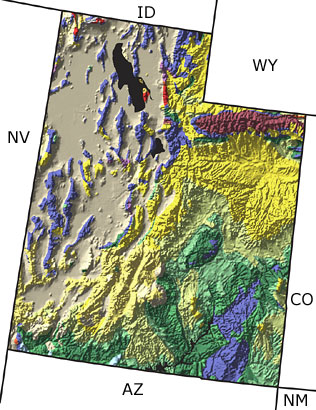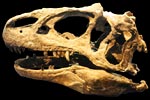Utah, US
|
|
|||||||||||||||||||||||||||||||||||||||||||||||||||||||||||||
Paleontology and geology
The Precambrian: Little is known about the Precambrian in Utah as most of these rocks are igneous and metamorphic and are buried beneath younger rocks. Some lightly metamorphosed Precambrian marine rocks exposed in the Uinta Mountains in the northeastern part of the state contain fossils of simple, single-celled organisms, indicating the presence of a marine environment.
The Paleozoic: The Paleozoic is well represented in Utah. Warm, shallow seas covered much of the state through most of this time interval. These seas were home to a diversity of organisms including clams, snails, trilobites, corals, brachiopods, algae, and sponges. Late Paleozoic (Carboniferous) sedimentary rocks are the most fossiliferous in the state. Fossils found in these rocks include nearly all groups of marine invertebrates, as well as rare occurrences of fossil fish.
The Mesozoic: Shallow seas retreated from the eastern part of Utah and broad, low floodplains developed during the Triassic. Some of the earliest dinosaurs roamed these floodplains, leaving behind their fossil footprints. Meanwhile, a shallow sea teeming with marine life still covered the western part of the state. Marine and non-marine conditions alternated throughout the Jurassic and Cretaceous. Great fields of sand dunes blanketed Utah, but were then covered with a shallow sea that once again flooded the region. Brachiopods, clams, snails, ammonoids, fish, and great marine reptiles lived in the seas, and a diverse and abundant dinosaur fauna roamed the land. During the Cretaceous, the seas retreated from Utah for the last time; Late Cretaceous deposits include fossils from numerous terrestrial vertebrates.
The Cenozoic: The Early Cenozoic (Tertiary) was a time of major uplift in Utah. Extensive fresh water lakes periodically covered the low areas of central Utah, leaving behind a diverse fossil record of the animals that lived in and around the lake system. These vast lakes were mostly gone by the end of the Tertiary. Uplift of the Colorado Plateau and the formation of the Basin and Range topography also began in the Late Tertiary. Utah developed its present topography during the Late Cenozoic (Quaternary). Regional uplift resulted in renewed erosion by rivers, forming the spectacular river canyons of the state. Lake Bonneville formed during a wetter interval in the Quaternary, only to shrink away through evaporation as the climate became more arid. The Great Salt Lake is a small remnant of ancient Lake Bonneville. Quaternary fossil vertebrates include saber-toothed cats, short-faced bears, giant ground sloths, bison, and musk ox, among many others.
Links to more on Utah paleontology
Organizations | Education and Exhibits | Research and Collections | Resources
OrganizationsEducation and ExhibitsSocieties and Clubs (showing 1 of 1 listings)
Utah Friends of Paleontology (UFOP): A statewide non-profit volunteer organization dedicated to preserving Utah's fossil resources through public education and volunteer support of sponsoring institutions. Certification classes train UFOP members to assist paleontologists in a variety of ways.
Government Agencies (showing 3 of 3 listings)
Utah Geological Survey Ground-Water & Paleontology Program: The Ground-Water & Paleontology Program maintains and publishes records of Utah's fossil resources, provides paleontological recovery services to state and local governments, and evaluates the quantity and quality of Utah's ground-water resources. The program also manages a paleontological training program for amateurs and provides state government and the public with detailed studies on paleontological and ground-water resources.
The Cleveland-Lloyd Dinosaur Quarry: This Bureau of Land Management website provides visitor information about the quarry. The quarry is unusual in that the majority of bones are from a single species of carnivorous dinosaur: Allosaurus fragilis.
Utah Geological Survey: The Utah Geological Survey site includes information about their ongoing projects, the geology and natural resources of Utah, including fossils, coal, oil, ground water, and minerals, as well as maps, publications, and resources for teachers.
Research and CollectionsVirtual Exhibits (showing 2 of 2 listings)
"Joe" the Dinosaur: Meet "Joe", the nearly complete skeleton of a baby Parasaurolophus that lived in Utah over 75 million years ago. The dinosaur, discovered by a high school student, was around 6 feet long and under a year old when it died.
Cambrian Explosion Fossils of Utah - America's Burgess Shale: The Middle Cambrian Wheeler Shale and Marjum Formation are exposed within the House Range west of Delta, Utah. Both formations are famous for their trilobites and other shelly fossils, but also contain a rich diversity of fossils of soft-bodied animals, some of which are shown in this gallery.
Physical Exhibits (showing 3 of 3 listings)
St. George Dinosaur Discovery Site at Johnson Farm: The St. George Tracksite has numerous dinosaur tracks preserved at the bottom of a 3 foot-thick sandstone layer, as well as fossil plants, invertebrates, and fossil fish. From the Utah Geological Survey web site.
St. George Dinosaur Discovery Site at Johnson Farm: This website includes images, an overview of exhibits, links to scientific publications on the site, and history of discovery for this locality with dinosaur trackways and other fossils.
Squatting Dinosaur Tracks at, the Johnson’s Farm: A vast number of tracks have been discovered at this site, including clear imprints of pelvis, tail and shuffling feet of a dinosaur, giving paleontologist the first evidence of a “squatting dinosaur.” From the Utah Geological Survey web site.
ResourcesOngoing Research Projects (showing 1 of 1 listings)
Killer Dinosaur Turned Vegetarian: Discovery of a new species of dinosaur from Utah, Falcarius utahensis, provided clues about how vicious meat-eaters evolved into plant-eating vegetarians. This site features photographs and information on the dinosaur.
Courses and Lectures (showing 1 of 1 listings)
Paleogeography of the Southwestern U.S.: The paleogeography of the southwestern U.S. from 1.8 billion years ago to 10 million years ago. Text and images by Dr. Ron Blakey from Northern Arizona University.
Field Guides (showing 2 of 2 listings)
Green River Paleobotany Project: This site is geared towards amateurs and professionals who collect fossil plants from the Parachute Creek Member of the Green River Formation in Colorado and Utah. The site provides an identification guide for more than 250 species of fossil plants and encourages collectors to submit images of their own fossils if they think they have found a new species.
Fossil Cephalopods in Utah: A reference to help provide information on the identity, biostratigraphy and location of fossil cephalopods found in the state of Utah.
Image Collections (showing 1 of 1 listings)
Fossil Images from Grand Staircase-Escalante National Monument: A pictorial essay of fossil life in the Grand Staircase National Monument, unveiled by Utah Geological Survey (UGS) staff.
General Reference (showing 3 of 10 listings)
Utah’s Wildlife in the Ice Age: This site, from the Utah Geological Survey, features a summary of northern Utah fossils, giving us a deeper understanding of wildlife that came before us.
Discovery of a New Pterosaur Tracksite at Flaming Gorge Reservoir: Significant tracksite along the shores of Flaming Gorge Reservoir containing trackways from a sauropaud dinosaur and pterosaurs, or flying reptiles. From the Utah Geological Survey web site.
Mammoth Tusk Discovery: This site from the Utah Geological Survey adds to our knowledge of life along the shores of Lake Bonneville during the Quaternary Period in Utah.

